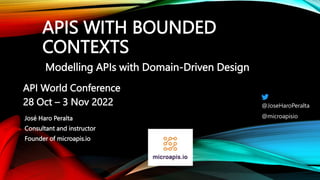
APIs with Bounded Contexts: Modelling Apis with Domain-Driven Design
- 1. APIS WITH BOUNDED CONTEXTS Modelling APIs with Domain-Driven Design José Haro Peralta Consultant and instructor Founder of microapis.io API World Conference 28 Oct – 3 Nov 2022 @microapisio @JoseHaroPeralta
- 2. $ whoami • I’m Jose • Consultant, author, instructor • Author of Microservices and APIs • Founder of microapis.io @JoseHaroPeralta @microapisio 35% discount code: ctwapiworld22
- 3. microapis.io 39% discount code: ctwapi21 One-click API mock servers @JoseHaroPeralta @microapisio
- 4. Connect with me! Twitter: @JoseHaroPeralta GitHub: @abunuwas Medium: @joseharoperalta /@python-geek LinkedIn: https://www.linkedin.com/in/jose-haro-peralta/
- 5. Agenda Complexity of creating good API design More in particular, good REST API design How domain-driven design helps to design better APIs Special case of data-driven applications
- 6. Ubiquitous APIs • Using domain-driven design to align with the business helps us create better APIs • Think about processes and flows instead of endpoints and HTTP status codes • How leveraging API design principles such as uniform interface helps us create ubiquitous APIs • Leveraging HTTP semantics helps us create ubiquitous APIs
- 7. Reality is more complex than textbook cases • Many projects start out as an experiment and/or PoC and then there’s pressure to build the production application quickly (the business case often depends on the speed of delivery) • In reality, we often figure out what we’re doing on the go (the domain and the subdomains become clear as we progress in our work) • The business often lacks terminology to refer to their own processes and flows and to their own “entities” • Data-driven applications are notoriously hard to model (everything is “data”)
- 8. APIs for data-driven applications anti-patterns • API conceived as data gateways • Lack of API design and validation • Lacking notion of operations • Oversimplification through CRUD (CRUDified APIs) • God models • Cluttered endpoints • Lacking HTTP semantics • Breaking uniform interface
- 9. Build a sales forecasting application • Digital transformation project in major international retail org • Automate sales forecasting • From two forecasts a year to rolling forecast • More accurate forecast • Being able to model multiple scenarios • Keep track of historical forecasts and compare
- 10. Starting with an experiment • We started with a small experiment • Early Machine Learning iterations proved successful
- 11. Building a PoC • Built a quick UI using Dash (Python library) • Weekly iterations
- 12. PoC validated – project kicks off Split UI and backend 1 Expose backend API 2 Operate at scale 3
- 13. Project kicks off – new architecture
- 14. API design challenges • It becomes clear that the business lacks terminology to refer to their own processes and flows, and to their “entities” • Different countries use different processes and flows • We think of states instead of different entities and we have a “God model”
- 15. API design challenges • We drag bad models from the PoC • Cluttered endpoints due to over-reuse • Very difficult to continue extending the API • 2 languages: business and data science
- 17. God models: using states instead of entities
- 18. Bad models
- 19. Cluttered endpoints • POST /forecast => retrieve raw forecast • POST /forecast + adjustments => create scenario • POST /forecast + adjustments + new stores => create new store forecast • PUT /forecast/{forecast_id} => create candidate • PUT /forecast/{forecast_id} => create submission
- 20. From states to entities Raw forecast Scenario Candidate Submission New store forecast
- 21. Modeling operations • Stop thinking in terms of URLs and HTTP methods • Start thinking in terms of operations • Decouple your backend data model from your API models • Leverage HTTP semantics • Enforce uniform interface
- 22. Start with operations, processes, and flows • Retrieve raw forecast • Create and update scenarios • Create and update candidate • Create submission • Create forecasts and scenarios for new stores
- 23. Use meaningful resource endpoints and leverage HTTP semantics
- 24. Conclusions • Changing the API is risky – can break integrations => address design issues early • Don’t think in terms of URLs and HTTP methods => think in terms of operations, processes, and flows • Don’t crudify your APIs – if an operation isn’t needed, don’t add it • Flexible models are bad => create discrete models for each entity • Clarity over reusability => don’t reuse endpoints and models
- 25. Thanks for listening! Twitter: @JoseHaroPeralta GitHub: @abunuwas Medium: @joseharoperalta /@python-geek LinkedIn: https://www.linkedin.com/in/jose-haro-peralta/ 35% discount code: ctwapiworld22
- 26. ADDITIONAL READINGS • Microservice APIs by J. Haro (mng.bz/nz48) • “Building and deploying reliable APIs with FastAPI” by J. Haro (https://www.twitch.tv/videos/1088283640) • Documentation-driven development for APIs by J. Haro (https://link.medium.com/m2A3rOxUfib) • “Developing API clients doesn’t need to be a pain” by J. Haro (https://link.medium.com/0B9vt7DUfib) • “How bad models ruin an API” by J. Haro (https://microapis.io/blog/how-bad-models- ruin-an-api) • “API-first development maturity framework” by J. Haro (https://microapis.io/blog/api- development-maturity)
- 27. ADDITIONAL READINGS • “Design patterns for modern web APIs” by D. Luecke (https://blog.feathersjs.com/design-patterns-for-modern-web-apis-1f046635215) • The design of web APIs by A Lauret (https://www.manning.com/books/the-design-of- web-apis) • Designing APIs with Swagger and OpenAPI by J. S. Ponelat and L. L. Rosenstock (https://www.manning.com/books/designing-apis-with-swagger-and-openapi) • API Design Patterns by JJ Geewax (https://www.manning.com/books/api-design- patterns) • Principle of Web API Design by J. Higginbotham (https://www.pearson.com/store/p/principles-of-web-api-design-delivering-value- with-apis-and-microservices/P200000007278/9780137355631)
